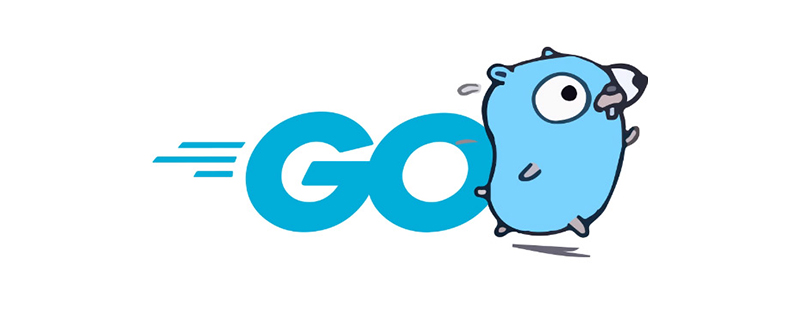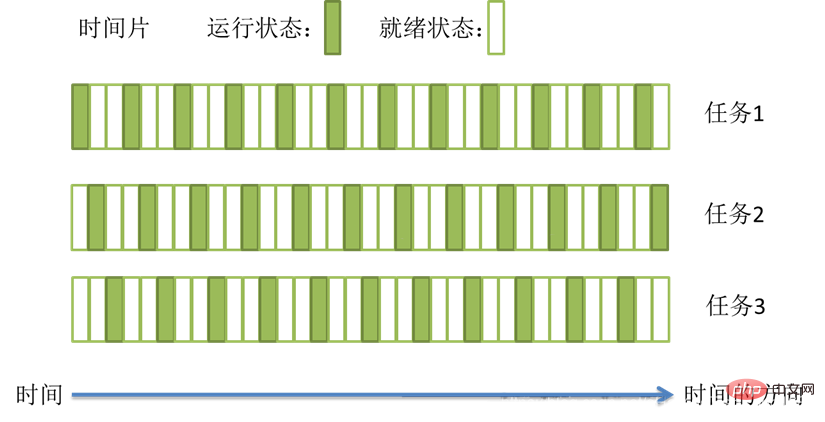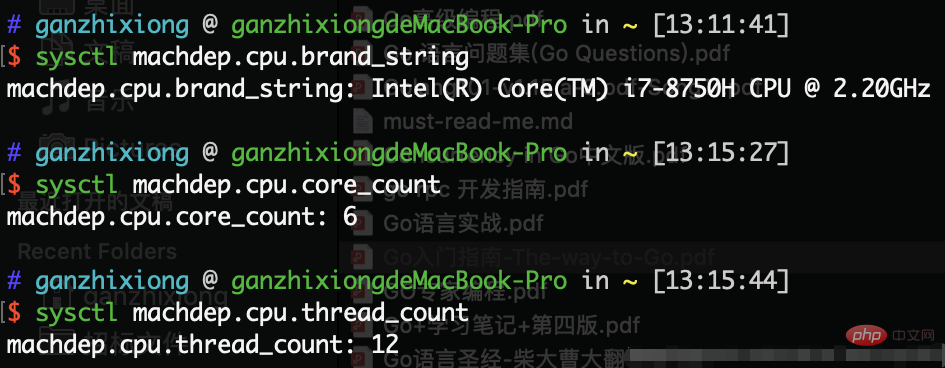What is the difference between threads and processes in go language
Difference: 1. Thread is the smallest unit of program execution, while process is the smallest unit of resources allocated by the operating system. 2. A process consists of one or more threads. Threads are different execution routes of code in a process. 3. Thread context switching is much faster than process context switching. 4. Process switching requires maximum resources and is very inefficient; thread switching requires average resources and has average efficiency. 5. The process has its own stack and the stack is not shared between processes; the thread has its own stack and shares the heap.

The operating environment of this tutorial: Windows 7 system, GO version 1.18, Dell G3 computer.
What are threads and processes?
A process
- is a program with certain independent functions on a data set The A dynamic execution process
- is an independent unit for resource allocation and scheduling by the operating system
- It is the carrier for the operation of the application
- Thread is a single sequential control process in program execution
- It is the smallest unit of program execution flow
- Is the basic unit of processor scheduling and allocation
- A process can have one or more threads
- The memory space of the program is shared between each thread
Task Scheduling
The task scheduling of most operating systems (Windows, Linux) adopts the time slice rotation preemptive scheduling method.
The scheduling method is as follows:
In a process, when a thread task is executed for a few milliseconds, it will be scheduled by the operating system kernel
-
Interrupt the processor through the hardware counter, force the thread to pause and put the thread's register into the memory
Determine which thread to execute next by looking at the thread list
Then restore the register of the thread from the memory, and finally resume the execution of the thread to execute the next task
This method guarantees Each thread is executed in turn. Since the execution efficiency of the CPU is very high and the time slice is very short, it quickly switches between tasks. It gives the impression that multiple tasks are being performed at the same time. This is what we Talk about concurrency.

The difference between process and thread
- Thread is the smallest part of program execution Unit, and process is the smallest unit for the operating system to allocate resources
- A process consists of one or more threads, and threads are different execution routes of code in a process
- Process switching requires the largest resources and is very inefficient; thread switching requires average resources and has average efficiency .
- The process has its own stack, the stack is not shared between processes, and is scheduled by the operating system
-
Threads have their own stack, share the heap, and are also scheduled by the operating system
Multi-threading and multi-core
Multi-core processorrefers to integration on one processor Multiple computing cores are installed to improve computing power. That is to say, there are multiple processing cores for true parallel computing, and each processing core corresponds to a kernel thread.
Each processing core corresponds to a kernel thread. For example:
- A dual-core processor corresponds to two core threads
- A quad-core processor corresponds Four kernel threads
- Kernel Thread (KLT) is a thread directly supported by the operating system kernel. The thread is switched by the kernel. The kernel schedules the thread by operating the scheduler and is responsible for mapping the thread's tasks to each processor.
Hyper-threading technologyCurrently, processors use
Hyper-threading technologyto combine a physical processing core Simulated into two logical processing cores , that is, two kernel threads. So the computers we see are generally dual-core and four-thread, or four-core and eight-thread. In the operating system, we see that the number of CPUs is twice the number of actual physical CPUs. For example, dual-core and four-threads can see 4CPUs.
For example, the mbp I am currently writing the article on is an i7 6-core 12-thread:
 Programs generally do not use kernel threads directly, but use the kernel A high-level interface for threads—Lightweight Process (LWP), which is what we often call
Programs generally do not use kernel threads directly, but use the kernel A high-level interface for threads—Lightweight Process (LWP), which is what we often call
.
CoroutinesCoroutines are based on threads and are more lightweight than threads. A thread can have multiple coroutines.
In traditional applications, a thread is usually created for network requests to complete business logic. If there are multiple requests, multiple threads will be created.
If you encounter a time-consuming I/O behavior, the thread will always be in a blocked state. If many threads are in this idle state (waiting for the thread to complete execution before executing), this will cause resource application If it is not thorough, the throughput capacity of the system will decrease.
The most common time-consuming I/O behavior is such as JDBC. The CPU will always wait for the return of the data I/O operation. At this time, the thread does not use the CPU to perform operations at all, but is in an idle state. Using too many threads at the same time will also bring more context switching overhead.
There are two solutions to the above problems:
- Single thread plus asynchronous callback
For example, Node.js, Java’s Vert.x - Coroutine
The purpose of the coroutine is to give up the current coroutine schedule and execute the next task when a long-term I/O operation occurs to eliminate the overhead of ContexSwith
- Thread switching is scheduled by the operating system, and coroutines are scheduled by users themselves, thus reducing context switching and improving efficiency
- The default Stack size of the thread is 1M, while the coroutine is more lightweight, close to 1K. Therefore, more coroutines can be opened in the same memory
- Because the coroutines are on the same thread, competition can be avoided. 2. Use locks
- Suitable for blocked and requiring a lot of concurrency Scenes. But it is not suitable for multi-threading of large amounts of calculations
The process of coroutine :
When I/O blocking occurs, the scheduler of the coroutine will schedule it
By yielding the data stream immediately ( Actively give up), and record the data on the current stack
After the blocking is completed, immediately restore the stack through the thread, and put the blocking result on this thread to run
The thread running in the Coroutine is called Fiber. For example, the go keyword in Golang is actually responsible for opening a Fiber, let func logic run on it.
Because the suspension of the coroutine is completely controlled by the program and occurs in the user state; the blocking state of the thread is switched by the operating system kernel and occurs in the kernel state.
Therefore, the overhead of coroutines is much less than that of threads, and there is no overhead of context switching.
Comparison of threads and coroutines
| Thread | Coroutine | |
|---|---|---|
| The initial unit is 1MB, fixed and immutable | The initial unit is generally 2KB , can be increased as needed | |
| Completed by OS kernel | Completed by user | |
| Design mode switching (switching from user mode to kernel mode), refreshing of 16 registers, PC, SP and other registers | Only three register values are modified: PC, SP , DX | |
| The resource occupancy is too high, frequent creation and destruction will cause serious performance problems | The resource occupancy is small, and it will not bring Serious performance issues arise | |
| Requires mechanisms such as locks to ensure data consistency and visibility | Does not require multi-threaded locking mechanisms , so there is only one thread. There is no conflict in writing variables at the same time. Shared resources are controlled in the coroutine without locking. You only need to determine the status, so the execution efficiency is much higher than that of threads |
The above is the detailed content of What is the difference between threads and processes in go language. For more information, please follow other related articles on the PHP Chinese website!

Hot AI Tools

Undresser.AI Undress
AI-powered app for creating realistic nude photos

AI Clothes Remover
Online AI tool for removing clothes from photos.

Undress AI Tool
Undress images for free

Clothoff.io
AI clothes remover

AI Hentai Generator
Generate AI Hentai for free.

Hot Article

Hot Tools

Notepad++7.3.1
Easy-to-use and free code editor

SublimeText3 Chinese version
Chinese version, very easy to use

Zend Studio 13.0.1
Powerful PHP integrated development environment

Dreamweaver CS6
Visual web development tools

SublimeText3 Mac version
God-level code editing software (SublimeText3)

Hot Topics
 1358
1358
 52
52
 1196
1196
 24
24
 What libraries are used for floating point number operations in Go?
Apr 02, 2025 pm 02:06 PM
What libraries are used for floating point number operations in Go?
Apr 02, 2025 pm 02:06 PM
The library used for floating-point number operation in Go language introduces how to ensure the accuracy is...
 Which libraries in Go are developed by large companies or provided by well-known open source projects?
Apr 02, 2025 pm 04:12 PM
Which libraries in Go are developed by large companies or provided by well-known open source projects?
Apr 02, 2025 pm 04:12 PM
Which libraries in Go are developed by large companies or well-known open source projects? When programming in Go, developers often encounter some common needs, ...
 What is the problem with Queue thread in Go's crawler Colly?
Apr 02, 2025 pm 02:09 PM
What is the problem with Queue thread in Go's crawler Colly?
Apr 02, 2025 pm 02:09 PM
Queue threading problem in Go crawler Colly explores the problem of using the Colly crawler library in Go language, developers often encounter problems with threads and request queues. �...
 How to ensure concurrency is safe and efficient when writing multi-process logs?
Apr 02, 2025 pm 03:51 PM
How to ensure concurrency is safe and efficient when writing multi-process logs?
Apr 02, 2025 pm 03:51 PM
Efficiently handle concurrency security issues in multi-process log writing. Multiple processes write the same log file at the same time. How to ensure concurrency is safe and efficient? This is a...
 In Go, why does printing strings with Println and string() functions have different effects?
Apr 02, 2025 pm 02:03 PM
In Go, why does printing strings with Println and string() functions have different effects?
Apr 02, 2025 pm 02:03 PM
The difference between string printing in Go language: The difference in the effect of using Println and string() functions is in Go...
 Why is it necessary to pass pointers when using Go and viper libraries?
Apr 02, 2025 pm 04:00 PM
Why is it necessary to pass pointers when using Go and viper libraries?
Apr 02, 2025 pm 04:00 PM
Go pointer syntax and addressing problems in the use of viper library When programming in Go language, it is crucial to understand the syntax and usage of pointers, especially in...
 How to solve the problem of Golang generic function type constraints being automatically deleted in VSCode?
Apr 02, 2025 pm 02:15 PM
How to solve the problem of Golang generic function type constraints being automatically deleted in VSCode?
Apr 02, 2025 pm 02:15 PM
Automatic deletion of Golang generic function type constraints in VSCode Users may encounter a strange problem when writing Golang code using VSCode. when...
 What is the difference between `var` and `type` keyword definition structure in Go language?
Apr 02, 2025 pm 12:57 PM
What is the difference between `var` and `type` keyword definition structure in Go language?
Apr 02, 2025 pm 12:57 PM
Two ways to define structures in Go language: the difference between var and type keywords. When defining structures, Go language often sees two different ways of writing: First...




